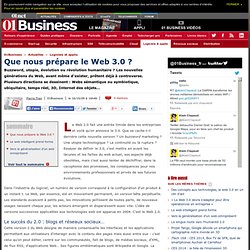

FLARManager: Augmented Reality in Flash. Dashboards pour la veille des médias sociaux, l'analytique et les alertes.
Après la Génération Y... la Génération C - Mode(s) d'emploi, tendances, conseils et actus sur le monde du travail. AnyBizSoft Document Software: Easy & Powerful PDF, EPUB Software. Windows. Google vs. Facebook by the numbers. Computerworld - With its still-in-limited-field-test social network Google+, Google looks poised to challenge Facebook head-on in the increasingly important social media space.

Some analysts give the edge to Facebook with its large head start -- the company claims more than half a billion active users worldwide, half of whom log onto the site each day. Other pundits point to Google's large number of users across multiple products along with its engineering prowess as factors making it a formidable challenger. How do the companies stack up head to head? Here's a look at some of the available statistics. Users Google has a clear edge globally, according to ComScore Data Mine: Google reached a billion unique visitors worldwide in May, while Facebook rang in at 713.6 million. Google's lead is narrower in the U.S., where it had 155 million unique visitors from desktop and laptop computers in May compared with Facebook's 140 million, the Nielsen Company reported. Revenues Employees Conclusion. Decentralized network system - Patent 6671737. This invention relates generally to networking systems, and more particularly, to a decentralized network system for networking heterogeneous devices which operates without a physical infrastructure and to a method of managing message exchanges between nodes in a decentralized network system.
The value of networking in business via intranets and for personal use via the Internet is undisputed. Networking enables large numbers of people and equipment to work cooperatively together at multiple locations. Traditional networking involves dedicated servers, workstations and wired transmission media. Wireless communication provides some flexibility in traditional network systems. However, infrared (IR) media requires a clear line-of-sight between transmitter and receiver. Devices such as printers, workstations, mobile workstations and other devices are frequently networked using traditional means. In a complex work environment, it is common for devices not to function as expected. Que nous prépare le web 3.0 ? web sémantique ubiquitaire symbiotique temps réel 3d internet des objets web squared. 01Business le 16/10/09 à 16h46 sommaire Le Web 2.0 fait une entrée timide dans les entreprises et voilà qu'on annonce le 3.0.

Que se cache-t-il derrière cette nouvelle version ? Un buzzword marketing ? Dans l'industrie du logiciel, un numéro de version correspond à la configuration d'un produit à un instant t. Le succès du 2.0 : blogs et réseaux sociaux… Cette version 2 du Web désigne de manière consensuelle les interfaces et les applications permettant aux utilisateurs d'interagir avec le contenu des pages mais aussi entre eux : c'est celui qu'on peut éditer, centré sur les communautés, fait de blogs, de médias sociaux, d'XML, de flux RSS, d'applications Web… Ses figures emblématiques sont Wikipedia et Google.